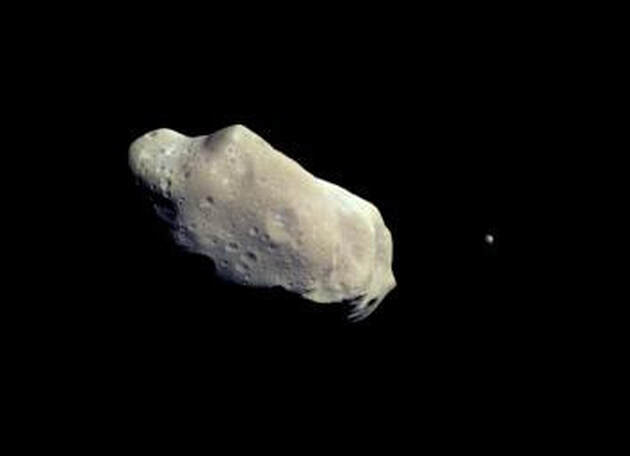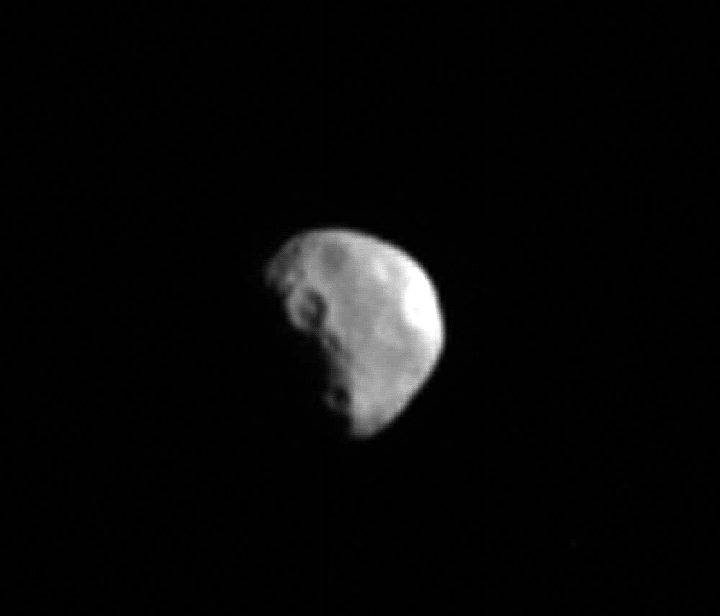Doublet impact craters on Earth (e.g. the Clearwater lakes crater remnants in Quebec and the Ries / Steinheim craters in Germany), Venus, Mars and the Moon (e.g. Messier A and B craters) led in 1996 to the proposition that ~15% of all NEOs are binaries. Prior to space probes and missions to asteroids, the observational technique used, and still used today for the majority of detections, was based upon light curve analysis.
Des cratères d'impact météorique binaire sur la Terre (par ex: le lac à l'Eau Claire au Québec; et les cratères de Ries/ Steinheim en Allemagne), Vénus, Mars, et la Lune (par ex: Messier A et B) ont mené en 1996 à la proposition que presque 15% des objets géocroiseurs (ou NEO de l'anglais, Near Earth Object) sont des astéroïdes binaires.
Avant les sondes spatiales et les missions vers des astéroïdes, la technique d'observation utilisée et encore utilisée pour la plupart des detections, était basée sur l’analyse de courbes de lumière.
In addition to this, if the asteroid, the ‘primary’, has a companion satellite, a ‘secondary’, there will be a superimposition (a variation) on the light curve due to the secondary’s revolution around the primary. Observed from Earth the secondary will at times transit / eclipse the primary and similarly, at times the primary will also eclipse the secondary. These transits and eclipses will vary the light curve. By using time elapsed and multiple observations, the variations can be distinguished and the secondary’s orbital period of revolution can be detected. This photometry technique was first used in 1901 to propose that 433 Eros had a companion satellite, although observations in Feb 2000 from the NEAR / Shoemaker probe (see section 7) showed Eros to be a single elongated object. The 1901 observations were misinterpreted due to the asteroids shape.
Stellar occultation, where an object eclipses a remote star, is also widely used in astronomy to give insights into the eclipsing object and in 1977, the technique was used to detect the binary nature of 6 Hebe. Compelling photometry (light-curve analysis) observations of 532 Heculina in 1978 also gave solid evidence for the existence of binary asteroids. However, these results and observations were considered rarities until the serendipitous discovery in August 1993 of the 243 Ida / Dactyl binary pair during the fly-past of the NASA Galileo probe to Jupiter.
The first triple system asteroid discovered was when the components of 87 Sylvia were found in February 2001 and August 2005 for the secondary and tertiary components respectively. The companions have been given the designation Romulus and Remus respectively; although these are not to be confused with 10386 Romulus (1996 TS15) discovered by the Italian astronomer Vincenzo Casulli (b.1944). Very few binary Trojans have been detected although this may be due to observational bias, i.e. they’re difficult to find. The Jovian Trojan 617 Patroclus was the first to be identified as binary, its secondary being discovered in September 2001, and is one of only four Jovian Trojans definitively known to have binary companions.
In total, there are currently ~285 confirmed binary pairs identified. This number includes 12 triple or multiple systems. There are a similar number of unconfirmed, suspected, binaries. Current estimates of the frequency of binary asteroid vary, with most assessments being of the order of ~2% of all main belt asteroids. Estimates for NEOs and planetary orbit crossing asteroids are higher at circa ~10%, probably due to the gravitational disruptions, hence fragmentation, this class of asteroids experience.
Some ‘individual’ asteroids certainly give the appearance of being aged contact binaries, examples being (Apollo class) 25143 Itokawa and (Amor type) 433 Eros. This also appears to be the case for some comets with for example, the short period (6.45 years) comet 67P/Churyumov–Gerasimenko (the subject and target of the ESA Rosetta probe) having a distinct bi-lobal shape.
Whilst binary asteroids are of distinct interest in themselves, a key feature of such systems is that they allow a very good estimate to be made of the mass of the asteroids. By measuring the orbital period of the secondary and using Newtonian gravitational mechanics (see e.g. section 7 of our book on the Sun) the mass of the total system can be determined. By taking an informed view of the differential masses of the pair, the individual masses can be assessed. This then permits density calculations to be performed and by comparison to spectral class (we will look at asteroid spectral classes in a future blog), and hence the masses can be determined of other asteroids for which an estimate of size can be made. This method cannot be used for contact binaries.
- YORP spin-up of rotation rate (see our March blog) leading to fission (break-up) of original objects;
- low speed collisions (see our April blog) producing break-off part/s of the original asteroid;
- tidal disruption of low tensile strength asteroids during their close approach(es) to either the major planets or the Sun. This would be most appropriate for both near-Sun asteroids (e.g. Apollo class) as well as the NEO and other planet crossing asteroids. The archetypical and class naming asteroid 1862 Apollo was confirmed as a binary in October 2005;
- orbital gravitational capture, especially within higher asteroid-number density areas such as the main belt or at / near the Lagrangian points. This latter mechanism is likely to be very much rarer than the above mechanisms as not only are the gravitational field strengths of asteroids very weak (due to their low mass), but the relative orbital speeds are most likely to be high in respect of the escape velocity of even the large of the asteroids.
We will look at Asteroid families.



